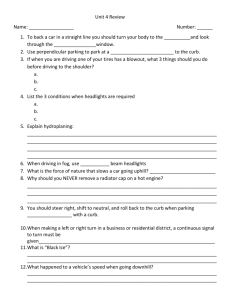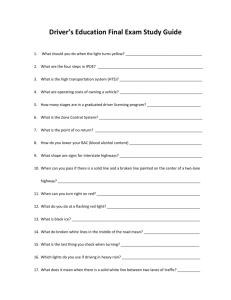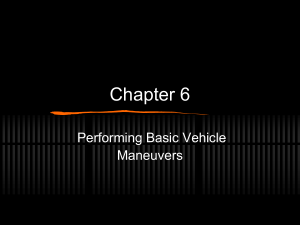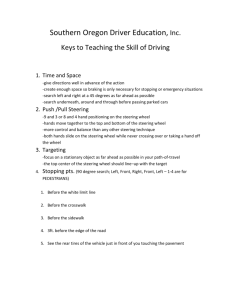Driving Procedures and Maneuvers
advertisement
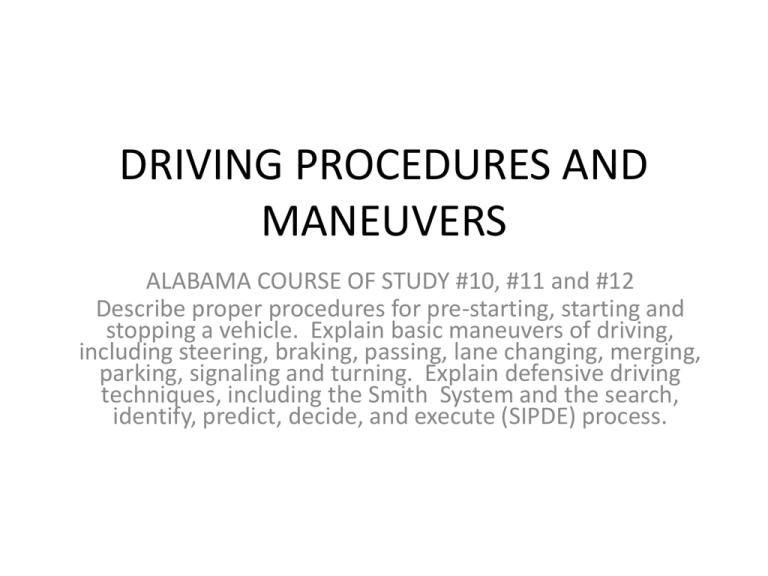
DRIVING PROCEDURES AND MANEUVERS ALABAMA COURSE OF STUDY #10, #11 and #12 Describe proper procedures for pre-starting, starting and stopping a vehicle. Explain basic maneuvers of driving, including steering, braking, passing, lane changing, merging, parking, signaling and turning. Explain defensive driving techniques, including the Smith System and the search, identify, predict, decide, and execute (SIPDE) process. Driving Procedures and Maneuvers Pre-Start Checks Pre-Start Procedures • • • • • • • Check condition of tires, lights, car body, etc. Check around the vehicle. Check intended path of travel. Close and lock doors. Adjust seats. Adjust mirrors and head restraints. Fasten safety belts. Outside The Vehicle Checks Check Tires • Tires should be checked to make sure they are not under inflated, worn or damaged. • It should be noted which way the tires are turned because this will be the direction your car will go as soon as it begins moving. Lights And Car Body • Make sure all lights and windows are clean and undamaged. • If it is cold, you may have to scrape snow or ice off your windshield. • At least once a week or when stopping for gas, check oil, coolant, battery, brakes, transmission and windshield-washer fluids. Check Around The Vehicle And The Intended Path Of Travel • Look for children playing nearby – each year about 200 kids under the age of six are killed while playing in the driveway. • Look for animals that may be hiding or sleeping near the vehicle. • Check for objects around the vehicle (toys, etc.). • Check under vehicle for stains that could indicate fluid leaks. Inside The Vehicle Checks And Procedures Close And Lock All Doors • Make sure all doors are securely closed and locked. • Put key into the ignition. Adjust Seats • Adjust seat so that you can clearly see the roadway and comfortably reach the floor pedals and other controls. Adjust Mirrors And Head Restraints • Adjust rearview and left side view mirrors so that you can use them with just your eyes and do not need to move your head. • Adjust right side view mirror for the best vision with the least amount of head movement. • Adjust your head restraint and have passengers adjust theirs. Fasten Seatbelts • Fasten your safety belt and make sure all passengers have fastened theirs. Remember the law! Get Ready To Start Your Engine! Starting the Car • Make sure the car is in park (neutral for a manual). • Depress clutch (only for a manual transmission). • Check for parking brake to be on (optional). • Turn ignition key “on” position and check gauges, then on to the “start” position. Release the key as soon as the engine starts. Put Vehicle in Motion • • • • • • • Put foot firmly on the brake, using the right foot. Depress clutch pedal (manual transmission only). Shift into desired gear (drive or reverse). Release parking brake (if applied). Check mirrors and blind spots. Signal intentions. Remove the foot from the brake (ease off clutch in manual transmission). • Apply gas pedal. • Cancel signal. Stopping and Securing the Vehicle • Check traffic (mirrors). • Signal intentions. • Lightly tap brake pedal to warn others you are slowing or stopping. • Apply smooth, steady, firm pressure to the brake pedal until the vehicle has stopped (apply clutch pedal in manual transmission). Stopping and Securing (cont.) • • • • • • • Set parking brake (optional). Shift into park (reverse for manual transmission). Take foot off brake (and clutch). Check to make sure all optional equipment is off. Unfasten seat belt. Remove key Open door, exit curbside (if possible), and lock doors. BASIC MANEUVERS • There are several basic maneuvers involved in driving safely and correctly: – Steering – Braking – Parking – Turning Push-Pull-Feed Steering • Safer because arms are not across the steering wheel at any time. • Preferred turning method if there are driver side airbags. • Hold steering wheel with right hand resting between 3 and 5 and left between 7 and 9. One hand pushes the wheel up toward 12 o’clock. At the same time, the other hand slides up to 1 o’clock for the right turn(11 for left), grasp the wheel, and pull it down. While pulling hand goes down, the pushing hand releases its grip and returns to original position. PUSH –PULL-FEED STEERING • This method lets you keep both hands on the wheel at all times. • It helps to reduce fatigue on long drives and gives better control in emergency situations. Steering Hand-Over-Hand • Method in which a driver’s hands cross when turning. • To turn right, use your left hand to push the wheel up, around, and down. At the same time bring your right hand across left forearm to grip wheel on far side. Then use your right hand to pull the side of the wheel up, around, and down. Reverse these for a left turn. “9 and 3” or “8 and 4” Hand positions on the steering wheel • Picture the wheel as a clock and place hand at these positions • Either of these positions provide you the best control in an emergency situation. • “8 and 4” is safer with driver side airbags. Thumbs Up • With either one of the hand positions, always rest thumbs on the wheel, not wrapped around. • This is safer and a more relaxed, comfortable hold. Steering in a Straight Line • When steering or tracking straight ahead, steer to a point in the center of your path of travel. • Look well ahead, not down. • Make slight, constant corrections with the steering wheel. • Don’t “oversteer” or wander in your lane. Steering (tracking) to the rear • When backing a vehicle, visibility through the rear window is limited. • To maximize visibility, turn your head and shoulders to look in the direction you are going. • When moving backward, the rear of the vehicle moves in the direction that you turn the wheel. • The front of the vehicle will move in the opposite direction (swing outward) • DON’T USE THE MIRRORS FOR BACKING. Look in the direction your vehicle is moving. • Keep looking back until your vehicle comes to a stop. Backing • When backing in a straight line, the left hand should be at the 12 o’clock position • The right hand/arm should be positioned so that the shoulders can turn. • When backing to the sides use both hands (push-pull-feed or hand over hand) and look in the direction you will be travel with quick glances to the front. BRAKING • There are different types of braking systems: – Anti-lock braking system (ABS) is the safest system. ABS is designed to the wheels from locking when the driver presses too hard on the brake pedal in an emergency. They do not shorten the stopping distance. – Conventional braking involves disc brakes. With this system pressure squeezes the brake pads against a flat metal wheel disc, producing the friction needed to stop the wheel from turning. BRAKING • With conventional braking, to avoid locking the brakes in an emergency situation, press the brakes until they almost lock then ease up slightly and back down. • The parking brake is attached by a cable to the rear wheels. It is used to prevent a parked vehicle from rolling. It can also be used in case of brake failue. Basic Maneuvers PASSING LANE CHANGING MERGING PASSING ANOTHER VEHICLE • Check the roadway ahead, signal, check mirrors and blind spot. • Return when you can see both headlights of the car being passed in your rearview mirror – don’t cut in too soon. • Don’t speed up when being passed. • It is illegal to pass on the shoulder of the road. • You will need to accelerate at least 10 mph faster than the car being passed (ok to speed??) PASSING • Use a very slight controlled movement of the steering wheel when moving to pass or change lanes – usually not more than1/8 of a turn. • Be alert for places where highways may narrow and don’t pass there. • Hold the steering wheel firmly when being passed by large trucks to adjust for possible wind gust. • Move out of a driver’s blind spot as quickly as possible when passing PASSING • Before risking a pass, consider the driver’s likely action – will they soon pull over or turn, will they need to swerve to avoid a pedestrian, cyclist, animal, etc.? • When in doubt as to the safety of a passing maneuver – don’t pass. • If the vehicle being passed demonstrates erratic behavior, drop back and re-evaluate the situation. • If, when passing, one misjudges the speed and distance of an oncoming car, try to brake and fall back behind the vehicle being passed. If this is impossible then speed up quickly to complete the Lane changing and Merging • Never move from one lane to another until you make certain that you do so safely. • To change lanes safely, follow these steps: – Check mirrors – Signal intentions – Check your blind spot – Adjust speed as needed – Move smoothly when time and space permits – Cancel signal, if necessary. SIGNALS • The vehicle is equipped with mechanical signal that communicates your intention to turn or change lanes. • To operate the signal, move the indicator arm upward for a right turn, and downward for a left turn. • Alabama law states that you must signal at least 100 feet prior to a turn, and a good rule of thumb, signal before you start braking. • Signal all changes in lane position. Turning • Before you make a turn you should consider: - Is there heavy traffic? - Do signs prohibit a turn? - Can I see clearly for 500 feet? -Do I have enough space? - Traffic and pedestrians TURNING RIGHT • • • • • • • • • Check the roadway ahead Choose the correct lane Signal your intentions Position car near the right side of the lane “turning right – keep it tight” Wait for a 6-8 second gap in traffic to your left. When your front wheels are even with the bend in the curve, start turning (using push-pull-feed or hand over hand) and follow the general curve of the curb. Look through the turn along your intended path of travel. Complete the turn by reversing your steering as you accelerate. Cancel your signal, if necessary. TURNING LEFT • Check the roadway ahead for vehicles, pedestrians, or other obstacles in your intended path. • Choose the correct lane • Signal your intentions • Position car near the left side of the lane . • Wait for a 9 second gap to the right and a 7 second gap to your left.. • Proceed into the intersection until just prior to the centerpoint of the intersection. • Keep your wheels straight and yield to any oncoming traffic. • Look through the turn along your intended path of travel. Turn into the lane just to the right of the centerline “elbow on the yellow” • Complete the turn by reversing your steering as you accelerate. • Cancel your signal, if necessary. Parking DO NOT PARK: - Within intersections - On a crosswalk of sidewalk - Within 20 feet of a crosswalk at an uncontrolled intersection - Within 30 feet of any flashing beacon, stop sign or traffic signal - In front of a driveway - On any bridge or in a tunnel - On the roadway side of any vehicle parked at the curb or edge of a highway (double parking) - Beside a curb that is painted yellow, or where official signs prohibit parking Parking the vehicle Perpendicular parking spaces are marked at a 90 degree angle to the curb. The steps are: - Stay 7-8 feet from parked cars for best visibility. - Observe all traffic conditions, check for other vehicles about to back out. - Use proper turn signals. Perpendicular Parking • Slow to 3-5 mph. Start turning when you can look down the side of the vehicle beside your chosen space. • Steer sharply and proceed slowly, checking for clearance of your front bumper. • As you move slowly forward, straighten the wheels and center in your space. • Stop just short of the curb or in line with the other vehicles. ANGLE PARKING On the right • Stay 5-6 feet from the parked vehicles to give yourself room to see and maneuver. • Observe traffic in all directions and be alert for vehicles leaving spaces. • Signal your intentions. • Proceed until you can see along the left side of the vehicle to the right of your space. Angle Parking • Steer sharply right and creep ahead at 3-5 mph into the space midway between the lines • Check the left front and right rear of your vehicle to make sure you have clearance • As you straighten the wheels, move forward until the front of your vehicle is aligned with those on both sides. Parallel Parking • • • • • Have a space at least 5 ft. longer than the length of your vehicle Check traffic, signal, and approach the parking space in the proper lane. Flash brake lights to alert following drivers of your intention to stop. Move parallel to the vehicle in front of the space, leaving about 2 feet between vehicles. Stop when the center door posts, or the backs of the front seats of the vehicles are even. Keep your foot on the brake, and shift to reverse. Parallel Parking • Back up, steering sharply to the right. • Align the back of the front seat with the rear bumper of the vehicle in front. • Continue backing slowly, straightening your front wheels, until your front bumper lines up with the rear bumper of the front vehicle. • Continue backing slowly, steering rapidly to the left. • Stop before making contact with the bumper of the vehicle behind the space. • With foot on brake, shift to drive and even up car in space. • Car should be within 12 inches of the curb. Parking on a Hill • When parking on a hill you must make sure your car does not roll into traffic if the brakes do not hold. • ALWAYS set the parking brake. • The only time that you are going to turn your wheels to the left is when you are uphill with a curb. PARKING ON HILLS Make sure the vehicle does not roll into traffic – set the parking brake and shift to park, then turn the wheels correctly: - Downhill with a curb * Turn wheels to the right or toward the curb. - Uphill with a curb * Turn wheels to left or away from the curb. - Uphill without a curb * Turn wheels to the right or toward the side of the road -Downhill with no curb *Turn wheels to the right or toward the side of the road 3 Point Turnabout • Make sure you can see for a great distance before beginning. • Not permitted on freeways, on curves, or near the top of a hill. • They are governed by local ordinances and there may not be a sign to warn you of someone making a 3 point turn. 3 Point Turnabout • Check traffic, signal, and stop as close to right edge of the curb as possible. Do not run off the roadway. Check both directions and make sure you have a 20-30 second gap. • Signal for a left turn. Look over left shoulder and move vehicle slowly while turning sharply left to bring the car to a stop in the opposite lane. 3 Point Turnabout • When front wheels are almost to the curb about 4 feet away, turn the wheel rapidly to the right. Stop the vehicle just short of the curb, again do not run off the roadway. • Check traffic to your left, then over your right shoulder. Shift to reverse, while backing slowly, turn the wheel to the extreme right position. About 4 feet before stopping, turn the wheel to the left. Keep looking back until stopped. 3 Point Turnabout • Shift into drive, check traffic, signal, move into proper lane, cancel signal, and accelerate to a normal speed. • TIP: Gear, steer, look, go (3 times) Defensive Driving • There are many different techniques that we can use to help minimize our risks while driving on the roadways. • There are 2 that are the backbone of safe driving. They are: Smith System, SIPDE Smith System • The Smith System is a series of principles designed to help one drive safely and defensively. • The Smith System consist of 5 important guidelines. Smith Guidelines: • 1. Aim High – look well ahead of your vehicle as you drive. Try to look 20 to 30 seconds ahead of you. • 2. Get the Big Picture – search the whole scene. Ex. As you approach an intersection search for vehicles, pedestrians, and others. Smith System • 3. Keep Your Eyes Moving- search the scene constantly. Stay alert for changes on the roadway or potentially dangerous conditions that might require you to make an adjustment. Smith System • 4. Make Sure Others See You- Communicate with all others using the roadway. Position your vehicle so others can see you. Signal your intentions to others. Ex. Tapping brake for stopping. Smith System • 5. Leave Yourself A Way Out – Position your vehicle so that you keep a margin of space to avoid a collision. • *** Be a defensive driver*** S.I.P.D.E. • The SIPDE process is an easy-to-use system for dealing with the driving challenge. • S.I.P.D.E. is an acronym for a 5 step process for defensive driving. SIPDE • “S”- Search the roadway and the off-road areas 20 to 30 seconds ahead for information that can help you with a path of travel. • “I” – Identify objects or conditions within 12 to 15 seconds ahead that could interfere with your planned path of travel. SIPDE • “P”- Predict what actions or changes in conditions on or near the roadway could increase possible danger. • “D” – Decide what action or actions you should take to help minimize risks. Ex. Steer right or left, brake, increase speed, reduce speed, etc. SIPDE • “E” – Execute the decision you have made. Executing a decision in most cases is making a routine maneuver. You might have to take some kind of emergency action. Smith System & SIPDE • Almost all of the procedures that make up these 2 processes, we do everyday. • We should do these procedures over and over again until we can perform them automatically. • Following these will help us to minimize risks on the roadway. REMEMBER!! The SIPDE and Smith System are ongoing processes. You will be reacting to one situation, while gathering information about a new one.

